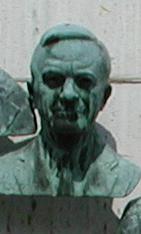Charles Armstrong (virologist)
Charles Armstrong (born September 25, 1886 in Alliance (Ohio) , † June 23, 1967 in Bethesda (Maryland) ) was an American doctor and virologist in the American health care system . He coined the name Lymphocytic Choriomeningitis (LCM) in 1934 after isolating the previously completely unknown LCM virus. He discovered in 1939 that poliovirus could be transmitted to cotton rats and began self-testing with nasal spray vaccinations.
academic career
After graduating from high school in his native Alliance, Armstrong first attended Mount Union College Preparatory School from 1905 to 1906 and then Mount Union College, where he graduated with a Bachelor of Science degree in 1910 . In 1915 he received his doctorate from the Johns Hopkins Medical School, an MD and completed a year as an assistant doctor at Yale-New Haven Hospital in New Haven (Connecticut) until 1916 .
Work in public health and virus research
On October 16, 1916, Armstrong was accepted into the US Public Health Service and served at the Ellis Island , New York immigration station for six weeks . He then worked as a ship doctor for the coast guard. From 1919 to 1921 he worked as an epidemiologist in the Ohio State Department of Health. For the next few decades from 1921 until his retirement in 1950, Armstrong worked and researched in the Hygienic Laboratory , which after organizational changes was finally named National Institutes of Health in Bethesda, Maryland in 1933 .
Armstrong was married to Elizabeth Alberta Rich from 1920 until his death and had a daughter, Mary Emma (born 1924).
Two main areas of research
Charles Armstrong gained general recognition in the professional world in two areas of virus research in particular: the discovery and naming of lymphocytic choriomeningitis (LCM) and the fight against polio .
LCM
In 1934, Armstrong isolated a previously unrecognized neurotropic virus found during the experimental transmission of encephalitis virus in the 1933 St. Louis Epidemic. The new virus was different from the St. Louis virus , and Armstrong found it in the nervous system, spinal fluid, blood, and urine of infected monkeys. Most monkeys had a more or less diffuse and irregular cell growth in the meninges . The majority of the animals also had a more or less pronounced lymph swelling of the choroid plexus , i. H. the cell membrane that surrounds the cerebral ventricles , which eventually led to the name of the disease as lymphocitary choriomeningitis .
polio

While he was still doing research at the LCM, Armstrong first succeeded in transmitting poliovirus (the rarer and less dangerous Type II Lansing ) from monkeys to small rodents, first to cotton rats ( Sigmodon hispidus hispidus ) and then in 1939 on white mice . This achievement was groundbreaking as it made it possible to observe many aspects of contagion and vaccination in humans that would hardly have been possible in monkeys. The discovery also spurred new efforts, such as those by John F. Enders , Frederick Chapman Robbins, and Thomas Huckle Weller , to transmit and detect other immunological types of poliovirus.
In recognition of his contributions to polio research and the fight against polio, Armstrong was inducted into the Polio Hall of Fame in Warm Springs, Georgia.
Honors for Charles Armstrong
- 1933 Honorary Doctorate (DSc) from Mount Union College, Alliance, Ohio
- 1934 The French medical profession honored Armstrong by naming the lymphocytic choriomeningitis he discovered as " La Maladie d'Armstrong ".
- 1938/39 Appointment to the advisory committee of the National Foundation for Infantile Paralysis
- 1944 Admission to the American Academy of Sciences in Department 10 (Pathology and Bacteriology)
- 1956 inducted into the Polio Hall of Fame , inaugurated January 2, 1958 in Warm Springs, Georgia .
- 1966 Awarded the Honorary Award for Outstanding Graduates from Alliance High School, Alliance, Ohio
- 1966 Congratulations from US President Lyndon B. Johnson on his 80th birthday
literature
- Edward A. Beeman: Charles Armstrong, MD: A Biography , 2007 also online here (PDF) (English)
- John R. Paul: A History of Poliomyelitis . Yale University Press, New Haven et al. a. (Connecticut / USA) 1971 (= Yale studies in the history of science and medicine, 6), ISBN 0-300-01324-8 , pp. 270-278 (English)
Individual evidence
- ↑ A detailed account of Armstrong's research on LCM can be found in Beeman, pp. 179-207
- ↑ named after the city of Lansing, Michigan, from where Armstrong got the human brain of a deceased boy.
- ↑ detailed description in: Beeman, pages 217–241
- ↑ Beeman, pp. 305-306.
- ^ Beeman, pp. 248-251
- ↑ to be found here in the academy's archive
| personal data | |
|---|---|
| SURNAME | Armstrong, Charles |
| BRIEF DESCRIPTION | American doctor and virologist |
| DATE OF BIRTH | September 25, 1886 |
| PLACE OF BIRTH | Alliance (Ohio) |
| DATE OF DEATH | June 23, 1967 |
| Place of death | Bethesda, Maryland |
